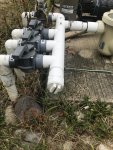5-7 days prior to closing the pool, I bring the pool up to near SLAM level based on my CYA and allow the levels to drift down. The pump will run a full 24 hour cycle for only the first day. After this, the pump will run around 4 hours until the last day. No more chlorine additions are needed.
Approximately 24 hours prior to closing, I add the Kemtek Poly-Quat 60 Non foaming, non-metallic algaecide and
allow the pump to run for 12-24 hours.
Your levels at closing are either at the highest or at normal, not in between. If you are using Poly-Quat, then you must allow your levels to come back down to normal. If you are not using the algaecide, then keep at SLAM right before you close. If you are using Poly-Quat, allow your levels to drift down to your normal CYA/FC levels. If you are not using the algaecide, you can close with the SLAM - higher levels. There is an interaction between high chlorine levels and the algaecide that does not work. Even the instructions state to keep your FC at a certain level. Post # 2, quote from (Chem Geek)
"Polyquat does not oxidize chlorine; it is the other way around where chlorine oxidizes Polyquat, or Polyquat gets oxidized by chlorine."
Please see post below.
Polyquat algaecides: Mode of Action


